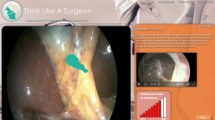Abstract
Aims
Making correct decisions is an integral part of surgical competency and excellence. The learning of this expert skill takes years to accumulate during training. To date there has not been an attempt to accelerate this learning process by developing a tool. In our present study we develop a self-appraisal computer software learning and assessment decision-making tool for laparoscopic surgery. It aims to accumulate several years of varied surgical experience, so the trainee can start to learn the complexities of surgical decision making in various types of cases. In this study we aim to validate the tool.
Methods
Three decision-making modules were developed in a computer program for laparoscopic cholecystectomy: knowledge of operation, operative surgical technique and operative task completion. The latter two modules were based on answering questions based on watching recorded live operations from a library of 100 recorded laparoscopic cholecystectomies of various grades. The questions were devised by two experienced surgeons with more than 14 years postgraduate surgical experience. To validate the tool two groups with varying surgical experience were assessed: intermediate and expert surgeons. These groups were determined by the number of laparoscopic cholecystectomies performed as well as of number of years of operative surgical experience.
Results
A total of 20 subjects were assessed, 12 intermediate and 8 experts surgeons. Mean time to perform the programme was 21 min (range 18–45 min). Using the Mann–Whitney test, p < 0.05, construct validity was demonstrated in the surgical technique and completion of task modules as well as the total combined scores.
Conclusions
Our computer-based decision-making learning tool for laparoscopic cholecystectomy seems to have face, content, concurrent and construct validities. Surgical decision making is a multifaceted process; by assessing how and why decisions are made effectively, focussed surgical training may be achieved. We aim in the future to determine if the self-appraisal decision-making tool improves or accelerates surgical training.





Similar content being viewed by others
References
Bogner M (ed) (2004) Misadventures in health care. LEA, Mahwah
Marshall JC (2006) Surgical decision making: integrating evidence, inference and experience. Surg Clin North Am 86(1):201–215
Youngson GG (2000) Surgical competence: acquisition, measurement, & retention. Royal College of Surgeons of Edinburgh, Edinburgh
Baldwin PJ, Paiseley AM, Brown SP (1999) Consultant surgeons’ opinion of the skills required of basic surgical trainees. Br J Surg 86(8):1078–1082
Cuschieri A, Francis N, Crosby J, Hanna GB (2001) What do master surgeons think of surgical competence and revalidation? Am J Surg 182(2):110–116
Spencer F (1978) Teaching and measuring surgical techniques: the technical evaluation of competence. Bull Amer Coll Surg 63:9–12
Sarker SK (2003) Courses, cadavers, and counsellors: reducing errors in the operating theatre. BMJ 327(7418):s109
Sarker SK, Chang A, Vincent C, Darzi SA (2006) Development of assessing generic and specific technical skills in laparoscopic surgery. Am J Surg 191(2):238–244
Sidhu RS, Grober ED, Musselman LJ, Reznick RK (2004) Assessing competency in surgery: where to begin? Surgery 135(1):6–20, Review
Guerlain S, Brook Green K, Luniewski MS, Mersch TC, Mitchell BA, Reed Poole G, Adams R, Forrest Calland J, Bovbjerg V, Chekan EG (2003) Training anatomy recognition through repetitive viewing of laparoscopic surgery video clips. Human Factors and Ergonomics Society. National Conference, Denver, Co
Hastie R, Dawes RM (2001) Rational choice in an uncertain world: the psychology of judgement and decision making. Sage Publications, Thousand Oaks, CA
Zsambok CE, Klein G (1997) Naturalistic decision making. Lawrence Erlbaum, Mahwah, NJ
Edwards W (1954) The theory of decision making. Psychol Bull 51:380–417
Chapman GB, Sonnenberg FA (eds) (2000) Decision making in health care: theory psychology, and applications. Cambridge University Press, New York
Kahneman D, Tversky A (1974) Judgements under uncertainty: heuristics and biases. Science 185:1124–1131
Janis IL, Mann L (1977) Emergency decision making: a theoretical analysis of responses to disaster warnings. J Human Stress 3(2):35–45
Sutton GC (1989) Computer-aided diagnosis: a review. Br J Surg 76(1):82–85
Orasanu J (2005) Crew collaboration in space: a naturalistic decision-making perspective. Aviat Space Environ Med 76(6 Suppl):B1 54–63, Review
Klein G (1998) The Recognition-primed decision model. In sources of power: how people make decisions. MIT Press, Boston
Dreyfus HL, Dreyfus SE, Athanasiou T (1986) Mind over machine: the power of human intuition and expertise in the era of the computer. Free Press, New York
Sarker SK, Chang A, Darzi A, Vincent C (2006) Decision Making in Laparoscopic Surgery. Presented at the 13th EAES annual meeting. Venice, Italy, June 2005. Surg Endosc 20:s10
Hammond K. Judgements under stress. Oxford Press
Clarke JR (1989) Decision making in surgical practice. World J Surg 13(3):245–251
Dominguez CO (2001) Expertise and metacognition in laparoscopic surgery. Human Factors Ergon Soc 45:1298–1304
Satish U, Streufert S, Marshall R., Smith JS, Powers S, Gorman P, Krummel T (2001) Strategic management simulation is a novel way to measure resident competencies. Am J Surg 181(6):557–561
Paisley AM, Baldwin P, Paterson-Brown S (2001) Feasibility, reliability and validity of a new assessment form for use with basic surgical trainees. Am J Surg 182(1):24–29
Brothers TE, Cox MH, Robison JG, Elliott BM, Nietert P (2004) Prospective decision analysis modeling indicates that clinical decisions in vascular surgery often fail to maximize patient expected utility. J Surg Res 120(2):278–287
Salem L, Veenstra DL, Sullivan SD, Flum DR (2004) The timing of elective colectomy in diverticulitis: a decision analysis. J Am Coll Surg 199(6):904–912
Larson JL, Williams RG (2005) Feasibility, reliability and validity of an operative performance rating system for evaluating surgery residents. Surgery 138(4):640–647; discussion 647–649
Servais EL, Lamorte WW, Agarwal S, Moschetti W, Mallipattu SK, Moutlon SL (2006) Teaching surgical decision-making: an interactive, web-based approach. J Surg Res 134(1):102–106
Statement of Disclosure
None declared
Author information
Authors and Affiliations
Corresponding author
Rights and permissions
About this article
Cite this article
Sarker, S.K., Rehman, S., Ladwa, M. et al. A decision-making learning and assessment tool in laparoscopic cholecystectomy. Surg Endosc 23, 197–203 (2009). https://doi.org/10.1007/s00464-008-9774-6
Received:
Revised:
Accepted:
Published:
Issue Date:
DOI: https://doi.org/10.1007/s00464-008-9774-6




